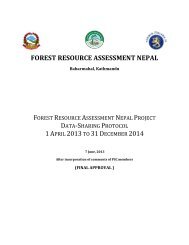Download - FRA Nepal
Download - FRA Nepal
Download - FRA Nepal
You also want an ePaper? Increase the reach of your titles
YUMPU automatically turns print PDFs into web optimized ePapers that Google loves.
The previous inventories mainly focused on timber and partly on biomass of the forest trees. Limited efforts were made to<br />
generate information on NTFPs and biological diversity of forest tree species. Protected areas were excluded from the NFI by<br />
defining inaccessible forest. In this backdrop, a NFI is urgently needed in <strong>Nepal</strong> to update forest statistics and address the<br />
present data needs.<br />
The previous NFI relied on centralized data collection approach and data collection procedures were quite expensive. The<br />
problem tree reveals that there is inadequate co-operation between organizations, lack of integrated natural resource data, and<br />
limited data processing capability. There is a clear need to emphasize decentralization of data collection and results<br />
dissemination. The institutional capacity of forestry organizations in information management need to be enhanced.<br />
Compilation of Forestry<br />
National forest management<br />
sector policy & programs<br />
decisions<br />
are not optimal<br />
are not optimal<br />
National & district District forest<br />
decisions are made<br />
with inaccurate data<br />
Accurate and actual forest forest<br />
decision making data<br />
is not available<br />
Inadequate information<br />
acquisition and sharing<br />
mechanism<br />
Lack of actual,<br />
integrated natural<br />
resource data.<br />
Limited data processing<br />
capacity and capability<br />
Lacking<br />
coordination in in<br />
data collection,<br />
data sharing<br />
procedures<br />
do not exist,<br />
centralized<br />
processes<br />
Data<br />
dissemination is is<br />
poor and<br />
only few<br />
organizations are are<br />
involved.<br />
Inventory data is is not not<br />
used for decision<br />
NTFP,<br />
Livelihood,<br />
Carbon, and<br />
Biodiversity<br />
data are missing.<br />
Growth models<br />
are missing.<br />
Efficient<br />
Monitoring<br />
System missing.<br />
Actual and<br />
accurate<br />
remote<br />
sensing data<br />
not available.<br />
Links to<br />
census,<br />
wildlife,<br />
agri-statistics,<br />
industrial<br />
statistics are<br />
weak<br />
Knowledge<br />
of GIS and RS<br />
data<br />
processing<br />
as well as<br />
Biometric& biometric&<br />
growth<br />
modeling<br />
limited<br />
Limited<br />
resources in in<br />
data collection<br />
and data<br />
processing<br />
Figure 1: <strong>Nepal</strong> national Problem Tree of forest information management<br />
3. Stakeholders and beneficiaries<br />
Although there are diverse stakeholders and beneficiaries of the project, they can be broadly categorized into immediate and<br />
indirect stakeholders. Immediate stakeholders will be directly involved in the NFI processes, but indirect beneficiaries only<br />
use the end products of the project. In the initial stage of the project, the national level forestry stakeholders will be identified.<br />
Moreover, <strong>FRA</strong> activities will be decentralized and capacity of local level forestry organizations will be utilized during the<br />
data collection procedures. Indirect stakeholders and beneficiaries will be involved in data collection and dissemination<br />
processes.<br />
3.1 Key Stakeholders and beneficiaries<br />
The following four groups are the key stakeholders of the <strong>FRA</strong> project:<br />
3.1.1 Public sector policy and decision makers<br />
National, regional and district level policy makers need <strong>FRA</strong> data for strategic planning, policy formulation and management<br />
decision. <strong>FRA</strong> project will generate data at national and regional scales to support forestry planning and policy decision.<br />
3.1.2 Cross-sectoral users<br />
Forests and forestry activities have great impact in different organizations. The <strong>FRA</strong> results are utilized by many<br />
organizations. For example, Department of Survey and Central Bureau of Statistics (CBS) use forest data for their purpose.<br />
11





